- Bernard Preston homepage
- Easy LUNCH
- Broad Beans on Toast
Broad beans on toast
Broad beans on toast would be called an antipasta in Italy; high in vegetable protein with added chopped boiled-egg or cheese, it makes a very satisfying dish.
If you really want to be posh, call it a bruschetta which just means "on burned-toast."
My favourite in fact is serving our broad beans on pan-fried toast made from sourdough bread.
They are also known as favas in much of the world and "tuinbonen" in Holland; garden beans. You won't find them in the shops.
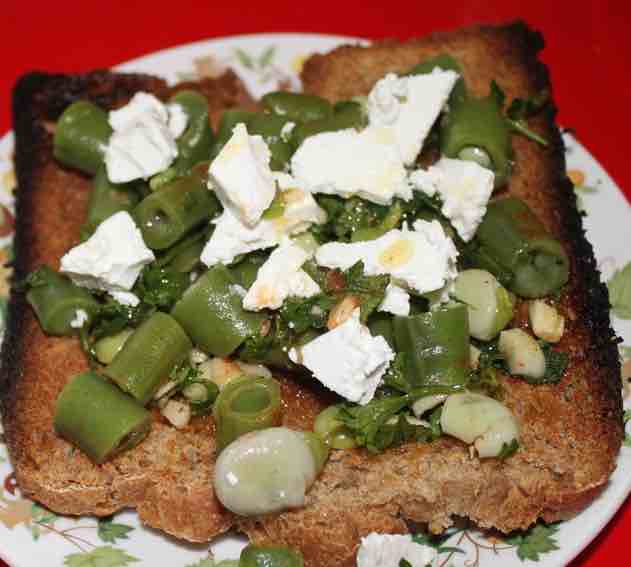
"A rose by any other name would smell just as sweet."
- Romeo and Juliet
You can turn this into a top-notch dish with broad beans from your garden and real bread made with 100% wholemeal flour. Both are difficult to find in the shops so the chances are alas you will be making your bruschetta just like everyone else from scratch. So here's the basic recipe.
Ingredients
- 1 cup of young shelled baby broad-beans
- 1/3 cup of cubed-feta or other favourite cheese
- Lime or lemon
- 1 fresh peppadew, other mild chili or a good shake of red-hot flakes
- 1 TBSP of your favourite herbs such as sweet-basil, parsley and mint
- 3 TBSP olive oil
- Pinch of salt unless using a cheese like feta
- 1 clove of garlic
- Slices of your favourite artisan-bread
Go for it
- Boil your broad beans for a few minutes in salted water until tender.
- Pop them out of their skins only if they appear old and hard; we all need more fibre.
- Chop the beans and tip them into a small-bowl.
- Shave off some of the lime-zest and then squeeze a teaspoon of the juice onto the beans.
- Add a tablespoon of the olive oil, the finely-chopped spices and herbs; salt, red pepper and cheese as desired.
- Toast your artisan-bread.
- Brush with the remaining olive oil and top each slice with the broad-bean mix.
Keep it simple, stupid
Which of these three forms of broad beans are you going to use?
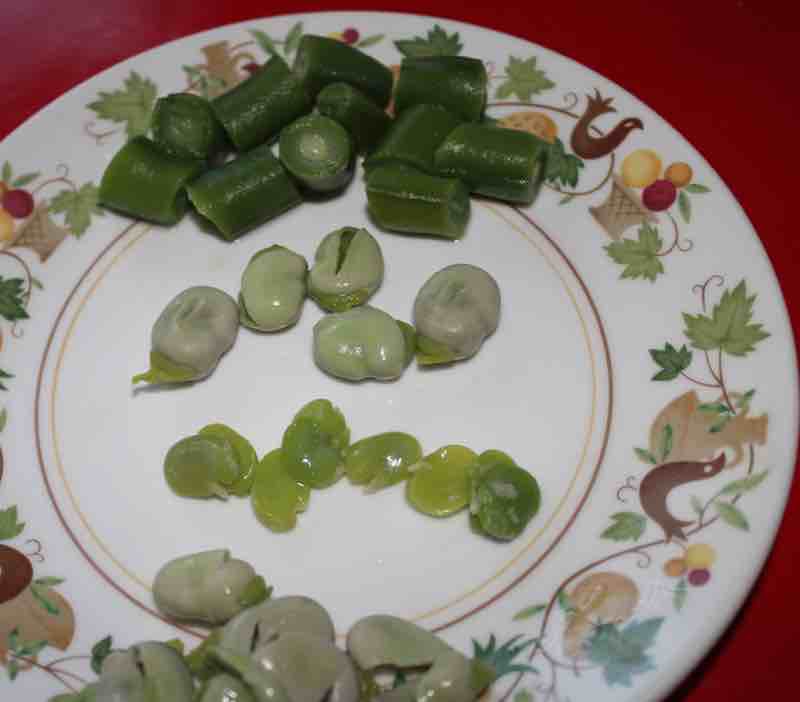 The skins are seen at the bottom of the plate; often they are discarded
The skins are seen at the bottom of the plate; often they are discarded- If you remove first the shell and then the skin which together contain most of the fibre, it will mean they are ultra-processed; that is the reason why it is reported that the glycemic index of fava beans is very high. It also takes a lot more time to prepare your bruschetta.
- Half the nutrients in citrus are found in the pulp. Using only the juice discards much of the vitamin-C, limonin and other phytochemicals; and yet more of the fibre too.
- Using the grill instead of the toaster takes much longer and wastes electricity; it contributes in some small but cumulative way to yet more greenhouse-gases.
- Brushing the toast first with olive oil and then with the cut garlic is tiresome, time-consuming and wastes much of the nutrition in the rest of the clove.
"Keep it simple, Stupid;" our slogan is slow food, made fast. Saving you time and money is all part of the Cyan Zone philosophy.
Let your food be your medicine
And now for the better way to make your broad-beans on toast.
Unfortunately your supermarket loaf will never qualify as medicine; most so-called wholemeal artisan bread is made from refined flour. And broad beans picked when too mature become hard and starchy. That is why most cooks first pod them; and then pop them to remove the skin.
Once you understand how net carbs work you will no longer want to skin your beans and eat white-toast; it's that fibre that prevents us from becoming constipated, obese and diabetic.
Remember that more than half of the L-dopa in broad beans is to be found in the young pods. That's the stuff that gives them their magical satiety factor. It's often being called the happy hormone.
So if you want food to be your medicine, growing broad beans and baking your own artisan bread is the way to go. Both will improve your well-being in leaps and bounds; more about that below.
Ingredients
- 1 cup of baby broad bean pods, freshly-picked, topped and tailed.
- 1 hard-boiled egg or a chunk of your favourite cheese, cubed.
- Lime or lemon.
- A fresh, mild but piquant chili; or red pepper-flakes.
- A pinch of turmeric.
- 1 clove or perhaps two of garlic; the richest source of allicin[3].
- 1 TBSP of your favourite herbs such as sweet-basil or parsley.
- 1 TBSP of olive-oil.
- Pinch of salt.
- Slices of artisan-bread.
Go for it
- Boil the young broad bean pods in salted water for a few minutes until tender.
- Drain, chop and tip into a bowl.
- Cube your feta cheese or crumb the hard-boiled egg; and add to the beans.
- Shave off some of the zest, peel the lemon and then cut a slice including the pulp; chop it up.
- Blend the finely-chopped herbs, including the garlic, chili and olive oil.
- Toast your artisan-bread well; even slightly burned so it is crisp.
- Top with your broad-bean mixture and serve while still warm. You could put them under a hot grill for a few minutes.
If raw garlic gives you indigestion, drop the clove into the boiling-water for one minute.
Broad bean pods and shells
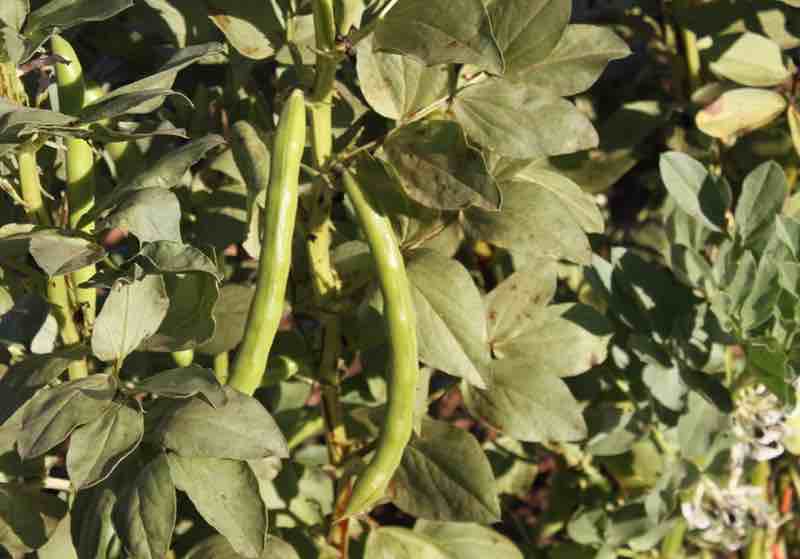
We humans like to remove most of the bran and germ from our wheat before baking so that it will slide deliciously down the throat; likewise most recipes recommend you discard both the pod and the bean skin. That is why they are listed as having a high glycemic-index; the whole dish is refined.
The tender young pods contain important nutrients, have invaluable fibre that lowers the GI and provide vital prebiotics for the teeming billions of bugs in the colon; so too the bean skin.
Only 5% of those eating typical grocery store food are getting sufficient fibre; serious bowel diseases are becoming more prevalent by the day.
It takes a little time to retrain the tongue and lips; ultimately we have to accept that whole foods are chewy. It even staves off dementia.
Dopamine is commonly associated with the "pleasure system" of the brain, providing feelings of enjoyment and exhilaration.
- Journal of Cell Physiology
Nutritionally speaking we live in a mad world that would have you remove the most important parts of your wheat and beans, discard them and then separately purchase those nourishing substances in capsules at great expense.
To get the most from your flour, we recommend purchasing a small mill and baking your own artisan bread; you can then have the very best loaf in the whole world, with all the finest nutrients and far superior taste for under a dollar. Dinkum, I do it every day.
Oh and if you are gluten intolerant you will find that by adding a sourdough-starter, your problems with a grumbling belly will be a matter of the past.
Alas you are most unlikely to find young broad-bean pods in the shops. You have to grow them yourself.
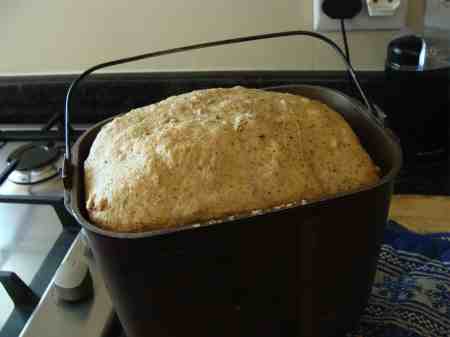
Time
Well-being that will take you to the stunning eighties and nineties with little or no medication, all your marbles and joints intact requires time and some planning.
If the thought of spending five minutes every morning milling the 100% flour for the best-tasting bread in the world and some time in the garden growing your own broad beans is just too much, then alas you must find your own way.
At our green home broad bean season means we can put up enough vegetable protein for the whole year.
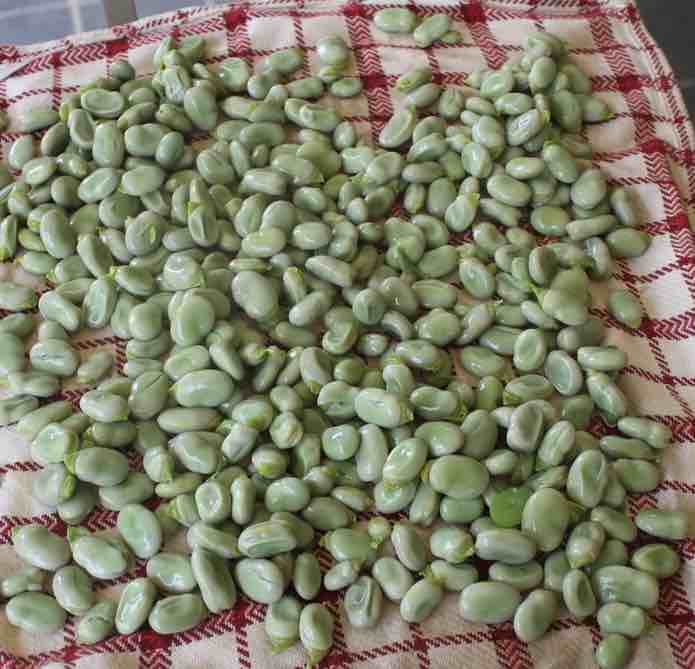
"There is increasing evidence that exposure to plants and green space and particularly to gardening, is beneficial to mental and physical health."
- Clinical Medicine (PMC6334070)[2]
Spending time in the garden is our way of participating in what is known as forest bathing; savouring the senses as you plant and nurture your food. Harvesting the mellow fruitfulness completes the blissful journey.
Those who enjoy life this way have little need for gyms; or psychiatrists for anxiety and stress. Nor do they often require the undoubted skills of doctors for their medicines either. The Blue Zone centenarians have shown us the way; it's only 10% genetic.
"When the world wearies, and society ceases to satisfy,
there's always the garden."
Broad beans on toast
Broad beans on toast make a wholesome meal in ten or fifteen-minutes.
We add just a little turmeric to many dishes; it gives a distinctive flavour whilst contributing to the fight against many serious diseases. Simply their anti-inflammatory compounds that inhibit the nasty COX 2 enzyme which causes pain and swelling in joints are sufficient reason; it has also been linked to preventing colon tumours[1].
"Luis had made her eat a particular kind of dried-ham at lunch with broad beans called habas which he said the Moors had loved."
- A Spanish Lover by Joanna Trollope.
Risk factors of Parkinson's Disease
Bernard Preston describes his journey of dealing with the risk factors of Parkinson's Disease. Broad beans on toast has become a staple.
Ketogenic diets
Made the usual way with broad-beans deprived of their skins and commercial bread you are likely to find the first recipe above will raise your blood glucose; it is fattening. So those advocating one of the many ketogenic diets will absolutely forbid meals like this.
Broad beans on toast made our way is central to all five of the Blue Zones where longevity is the norm. The way I see it is that we either take the time to grow and prepare wholesome foods, understand that they are rather more coarse because of the fibre or accept that medication and an early demise will most likely be our lot.
We live and die by the choices we make. I simply cannot abide by the thought that I must be constantly counting calories on this or that diet. Give me rather chewy broad beans on toast made our way.
According to Obesity Reviews 42% of adults worldwide are trying to lose weight[2]. Join those who bake their own wholemeal bread and grow broad beans; you can be assured you'll never again have to go on another diet.
Meals do take longer to eat. Strangely scientists have found that those who chew their food thoroughly are less likely to lose their marbles.
Learning how to plant broad-beans is what enabled me to control the tremor in my right hand. It's all about dopamine, the happy hormone.
Freezing broad beans makes them available all year round.
Allicin is an extremely important nutrient found chiefly in garlic. Interesting research in the UK found that drinking a glass of milk a day, whole or skimmed, reduced the risk of bowel cancer by 17%.
"Eating a plant-based diet rich in fruits, vegetables and nuts is much more likely to benefit your gut bacteria than supplementing with probiotics; seeds, beans and whole grains too."
- Tufts school of nutrition-science and policy
When browsing use right click and "Open Link in New Tab" or you may get a bad gateway signal.
Newsletter
Our newsletter is entitled "create a cyan zone" at your home, preserving both yourself and Mother Earth for future generations; and the family too, of course. We promise not to spam you with daily emails promoting various products. You may get an occasional nudge to buy one of my books.
Here are the back issues.
- Lifestyle and ideal body weight
- What are ultra-processed foods?
- Investing in long-term health
- Diseases from plastic exposure
- Intensive lifestyle management for obesity has limited value
- A world largely devoid of Parkinson's Disease
- The impact of friendly bacteria in the tum on the prevention of cancer
- There's a hole in the bucket
- Everyone is talking about weight loss drugs
- Pull the sweet tooth
- If you suffer from heartburn plant a susu
- Refined maize meal and stunting
- Should agriculture and industry get priority for water and electricity?
- Nature is calling
- Mill your own flour
- Bake your own sourdough bread
- Microplastics from our water
- Alternative types of water storage
- Wear your clothes out
- Comfort foods
- Create a bee-friendly environment
- Go to bed slightly hungry
- Keep bees
- Blue zone folk are religious
- Reduce plastic waste
- Family is important
- What can go in compost?
- Grow broad beans for longevity
- Harvest and store sunshine
- Blue zone exercise
- Harvest and store your rainwater
- Create a cyan zone at your home
Did you find this page interesting? How about forwarding it to a friendly book or food junkie? Better still, a social media tick would help.
- Bernard Preston homepage
- Easy LUNCH
- Broad Beans on Toast
Address:
56 Groenekloof Rd,
Hilton, KZN
South Africa
Website:
https://www.bernard-preston.com